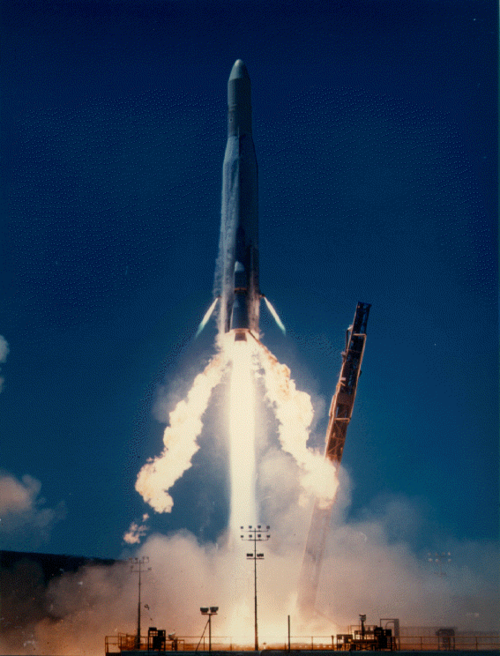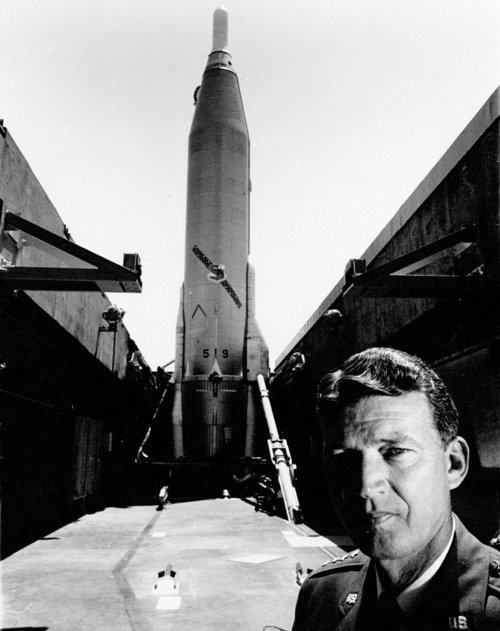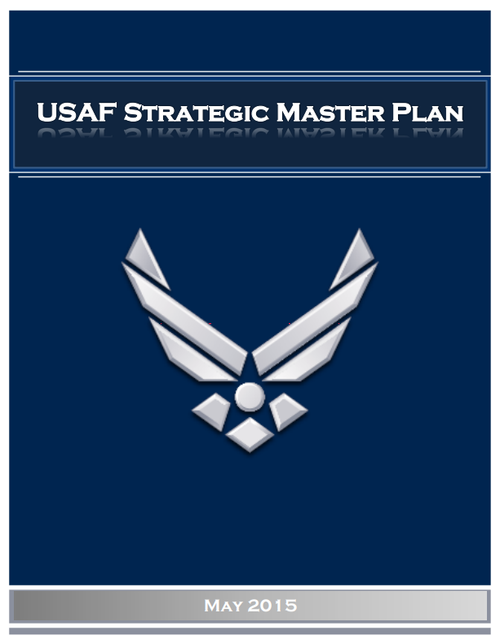By Kareen Hart
WHEN AT THE LEADING EDGE OF TECHNOLOGY AND PLOUGHING NEW GROUND…IF YOU DO NOT HAVE FAILURE EVERY NOW AND THEN, YOU ARE NOT TAKING ENOUGH RISKS.
—GENERAL BERNARD SCHRIEVER
An inherent tension exists in U.S. military culture. Intellectually, military members recognize the need to embrace technological innovation and change to survive in a complex and adaptive environment, yet the military organizational structure favors slow and deliberate development. Bureaucracies prefer stability, because innovative ideas are inherently risky and can create losses if they fail. The safer strategy is to embrace tried and true approaches, which are both easier to defend from an investment standpoint, and comfortable and familiar.[1] Therefore, particularly in an age of fiscal limitations, the military is more apt to invest in proven technologies and to find efficiencies that it is to experiment with innovations. It is hard to accept risk when you are in the lead. So how do strategic innovators resolve this paradox? The answer lies in changing the military mentality.
The U.S. military suffers from an incumbent, or status quo, mentality; it has become complacent due to its superpower status. For decades, it has had the freedom to operate whenever and wherever it wanted. Adversaries have used that time to study U.S. forces and their methods. Therefore, to innovate and out think the enemy of the future, U.S. strategic innovators need to embrace a challenger mentality. That means not only conducting traditional analysis of adversary strengths and weaknesses, but also learning to red team their own systems to look for vulnerabilities and weaknesses a challenger could exploit. There are three general areas where America is already at risk: technology, organizational culture, and organizational structure.
Identifying future technological gaps is one of the most difficult tasks for strategic innovators, placing pressure on them as they attempt to predict the future. The pressure here is high, because new technologies can spiral away from their original, intended purpose. It can feel uncomfortable to back a radically new concept, but the strategic innovator must acknowledge the risk of technological momentum, and accept that technological growth occurs at an exponential rate.[2] If the U.S. continues its status quo mentality, focusing only on incremental improvements or next-generation evolutions, it will be vulnerable to a risk-tolerant adversary gaining the technological edge.
For decades, the U.S. has remained confident in the military advantage provided by first- and second-offset technologies of nuclear weapons, stealth, and precision munitions. Looking to the future, though, revolutionary technologies will likely focus on the fields of artificial intelligence (AI), autonomous robotics, bioengineering, and information operations (cyber and communications) weapons.[3] In that scenario, China is America’s biggest threat. China is investing heavily in revolutionary new technology, particularly artificial intelligence, which could quickly outstrip U.S. military developments. “Rapid Chinese progress has touched off a debate in the United States between military strategists and technologists over whether the Chinese are merely imitating advances or are engaged in independent innovation that will soon overtake the United States in the field.”[4] Based on this scenario, the strategic innovator must look for ways to encourage U.S. investments in revolutionary technologies to challenge Chinese growth.
RADAR GAVE THE BRITISH THE TECHNOLOGICAL EDGE THEY NEEDED TO SURVIVE THE BATTLE OF BRITAIN, ALLOWING THEM TO WISELY HUSBAND CRITICAL RESOURCES BY ONLY LAUNCHING FIGHTERS WHEN ALERTED OF INCOMING ATTACKS.
Proponents of soft technological determinism and technological momentum both recognize the “history of technology is a history of human actions.”[5] This is largely because technological innovations often occur, especially during war, to counter an adversary’s advances. An example of this is development of radar during the Second World War. The Germans developed the technology in the early 1900s, and by 1938 the German Navy and Luftwaffe had installed a basic radar system in several of their vessels for use with gun-laying.[6] However, it was not until 1934 when Robert Watson-Watt from the British National Radio Laboratory persuaded the Committee for Scientific Study of Air Defense to test the ability of radio waves to detect aircraft that the technology took off.[7] Taking a large bet on the revolutionary technology paid off for the British in this case; even though the initial five experimental stations were only able to demonstrate limited performance, the Air Ministry recognized the potential of the innovation. This led to the authorization and construction of twenty stations as part of the Chain Home defense network.[8] Radar gave the British the technological edge they needed to survive the Battle of Britain, allowing them to wisely husband critical resources by only launching fighters when alerted of incoming attacks.[9]
...EVEN REVOLUTIONARY INNOVATIONS HAVE A SHORT LIFESPAN OF ASYMMETRIC ADVANTAGE.
However, radar development also highlights the challenge of sole reliance on revolutionary technology due to the cat and mouse game of move-countermove. Particularly during wartime, even revolutionary innovations have a short lifespan of asymmetric advantage.[10] For example, once radar proliferated, militaries quickly developed both mechanical and electric jamming methods to degrade radar’s advantage. Eventually, this resulted in counter-countermeasures such as anti-jamming equipment and frequency-hopping radar, highlighting how, in the words of Edward Luttwak, “each action is apt to evoke a conscious and creative outmaneuvering reaction, which induces the paradoxical coming together of success and failure in a manner all the more dynamic if the initial action is of strong effect.”[11]
What this means for the strategic innovator is they should employ a hedging strategy based on small bets. Additionally, per the challenger mentality, the military must ensure they understand and can apply innovative technologies, but they must also continually search for ways to counter that innovation. For example, with the successful setup of Chain Home defense, the British did not rest, but immediately began work on duplicate transmitters for redundancy and installation of anti-jamming equipment.[12]
EMBRACING ORGANIZATIONAL CHANGE
Even if a strategic innovator has made the right bets on technology, how do they convince the military to adopt it? In a case like radar, the British faced an existential threat, making a case for adoption fairly straightforward. However, radar would have been ineffective if used alone. Successful employment first required a change of organizational culture from strategic bombing to defense, along with the structural pairing with the fighter control system. Therefore, particularly when dealing with high risk, revolutionary change, innovative strategists become the linchpin for changing military culture. They are responsible for shaping and directing the initial organizational structure, and making sure the team/organization has the leadership and support required to implement and test the technology successfully.
One of the best examples of this in U.S. history was General Bernard Schriever’s leadership during the Atlas intercontinental ballistic missile (ICBM) program. Nuclear weapons, particularly ICBMs, marked a revolutionary jump in weapons technology. Ballistic missile development faced an uphill battle in acceptance, challenged by the “inertia, or conservative technological momentum” of both the U.S. Air Force's institutional structure and technological development capabilities.[13] That is because ICBMs threatened the cultural preeminence of Air Force pilots and had to cope with the scientific challenge of developing a working gyroscope (among other technological challenges).[14] Without pre-existing technology to rely upon, the call for innovation was led by the public outcry to find a solution to deal with the perceived existential threat posed by the Soviet Union; the public felt challenged.[15]
THE ATLAS PROGRAM DEMONSTRATES HOW CRITICAL IT IS TO PLACE THE RIGHT INDIVIDUALS IN POSITIONS OF POWER TO ADVANCE INNOVATION INTEGRATION AND ACCEPTANCE.

Atlas-E/-F with solid fuel upper stage (ICBM converted to satellite launcher) launching military payload (U.S. Navy Photo Wikimedia)
A confluence of circumstances thus spurred the missile revolution: public outcry over Soviet developments, the election of President Eisenhower, and the successful technological feasibility testing of miniaturized nuclear warheads. Recognizing these events, the Air Force formed the new Strategic Missiles Evaluation Committee, also known as the Teapot Committee, to start looking at the Atlas ICBM.[16] The Teapot Committee represented both the opportunity and barriers inherent in organizational culture change. On the one hand, it provided the chance to meld academia, commercial development, and military research into one interconnected web to achieve political interests. On the other hand, it gave political and commercial interests a say over the development of military technology.[17] General Schriever was critical to the conversation at that juncture. Schriever was not only a strategic innovator, but also a system builder, someone who understood the cross-functional and disciplinary approaches needed to oversee the project from all angles. He also had the rank and charisma to push through results when roadblocks arose.[18] He was also adept at coordinating the action between local and global networks, serving as a single focused point of centralized control that could shape and manage the obligatory point of passage between the two networks.[19]
...BY INVESTING IN MULTIPLE TECHNOLOGIES DEVELOPED IN PARALLEL, SCHRIEVER ASSUMED COST AND OPERATIONAL RISK BY RECOGNIZING THERE WOULD BE TESTING FAILURES.

Atlas, the Air Force’s first Intercontinental Ballistic Missile, was a national priority and one of Gen. Bernard Schriever’s major achievements. (Wikimedia)
Additionally, Schriever was a maverick.[20] He was familiar enough with the system to work within it, but bold enough to challenge institutional barriers and institute new ideas. For example, he initiated long-term cultural change by sponsoring a new generation of missileers who were interested in ICBM operations, and then backed them by ensuring they would have promotion and leadership opportunities within the U.S. Air Force.[21] Additionally, by investing in multiple technologies developed in parallel, Schriever assumed cost and operational risk by recognizing there would be testing failures. At the same time, he encouraged acceptance of failure as learning versus a termination criterion.[22]
The Atlas program demonstrates how critical it is to place the right individuals in positions of power to advance innovation integration and acceptance. Leaders without the right personality are liable to fall back to the status quo, seeking out routine, evolutionary solutions instead of embracing a challenger mentality.[23] That is because “in bureaucracies the absence of innovation is the rule, the natural state.”[24]
CHALLENGING ORGANIZATIONAL STRUCTURE
Bureaucratic inertia affects not only organizational culture, but also organizational structure. The federal acquisitions regulations and lobbyists for the military-industrial complex do not promote radical innovation, but rather incentivize the status quo.[25] Therefore, the strategic innovator must look for opportunities to convince military, contractor, and civilian researchers to pursue a challenger mentality by looking for potential vulnerabilities and opportunities. During crises, the government can institute a command-driven economy, directing where to funnel investments and resources, and selecting large development opportunities. However, during peace, it is far more common to see market-based economies where commercial interests rule.[26]
Hence the Air Force’s adoption of fast following commercial development; the U.S. Air Force may not have the resources or knowledge base to lead innovation on its own anymore, but it cannot afford to fall behind. This means strategic innovators must help push for structural integration of dual-use technologies that benefit both the military and civilian sectors. Examples include, shared innovations like ARPANET’s evolution into the commercial internet; recent military adoption of quad-copters for intelligence, surveillance, and reconnaissance; or 3-D printing of spare parts.
The strategic military innovator can also look to the commercial sector for ideas on how to handle organizational restructuring. While the military is often risk-averse, commercial companies frequently accept high-levels of risk to maintain relevance. Technological momentum in the private sector is not based on a military threat, but the challenge of increasing market share relative to competitors. Just think about Blockbuster and Netflix. When Netflix opened in 1998, both companies provided DVD-rental services. Blockbuster focused on brick-and-mortar stores, whereas Netflix always had a remote presence—first via mail, then via streaming digital content. Blockbuster eventually moved to offer digital rentals, but was years behind in a field growing exponentially; it could never catch up.[27] Yet even after Blockbuster’s collapse, Netflix did not rest on its laurels, taking on more risk by developing original content based on analysis of consumer desires.[28] The Netflix business model, therefore, can serve as an example of how competition and new technology can lead companies to restructure for maximum effect.[29]
...NOT EVERYONE CAN OR SHOULD BE INNOVATING...
But how exactly is mission expansion structurally handled? In The Other Side of Innovation, the authors discuss the need to maintain core competencies via a performance engine, while breaking out small, dedicated teams to pursue innovative ideas.[30] The basic premise is that not everyone can or should be innovating because core competencies help a company maintain its economic presence. However, companies who wish to expand should dedicate small teams to experiment with novel concepts for growth and development.
Key steps to establish an innovation team include first identifying the essential skills needed by the small team, then hand-select appropriate candidates (possibly via outside hires to break institutional memory). Next, give the team the time, resources, and support they need to experiment and learn via fast failure without the threat of termination. Not every small team will succeed, but for those innovations that do, the product or concept will be incorporated into the core mission before the cycle begins again.[31]
CONCLUSION

This article covered the three most significant areas of influence for strategic innovators and the U.S. military moving forward. In technological development, the U.S. must embrace the challenger mentality and start making small bets to hedge on diverse areas of technological development. The U.S. currently holds a technological advantage over its adversaries, but the gap is dwindling. Artificial intelligence and digital computing are changing the face of next-generation weapons, and with exponential growth and development, the U.S. cannot afford to fall behind. That is why the pursuit of game-changing technologies is one of the five strategic vectors outlined in the Air Force's Strategic Master Plan.[32] Innovation adoption is a positive step, but without commiserate cultural and structural changes, the technology alone is useless.
Early integration and training will help clear the second hurdle of cultural barriers to technological system adoption. However, reconstitution of the nuclear enterprise, new tanker development, and munitions recapitalization stretch resources already depleted by sequestration. Therefore, it is vital to handle each project with a systems builder’s approach. Integration and efficiency will be critical, as will identification of innovative program leaders who understand how to work the system.
Finally, structural challenges will continue. With the U.S. moving from its role as lead innovator to fast follower, it must acknowledge the value of high-risk investments. Not all new partnerships will pan out. Companies may have promising technology but compromised supply chains, or be more focused on profit than meeting requirements. That does not mean strategists should withdraw. Instead, they must learn how to categorize failure as learning and inculcate long-term changes to inspire innovation from both the bottom-up and top-down.
Technological momentum will always pressure strategists to innovate, but the exponential difference between industrial-age and information-age warfare means the United States now has a choice. It can embrace the challenger mentality, accepting a high-risk/high-reward strategy of betting on strategic innovations, or it can settle for the status quo of tried-and-true technology and risk losing its technological advantage.
Kareen Hart is an officer in the U.S. Air Force, a graduate of the Blue Horizons program, and a student at the School of Advanced Air and Space Studies at Maxwell Air Force Base, AL. The views and conclusions expressed in this article are hers alone and do not reflect the official position of the U.S. Air Force, the Department of Defense, or the U.S. Government.
This article appeared originally at Strategy Bridge.
No comments:
Post a Comment